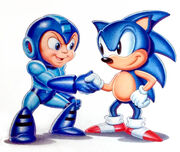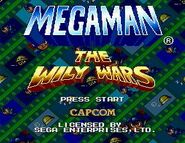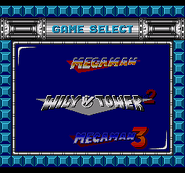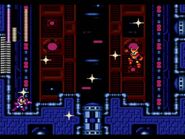Mega Man: The Wily Wars, known as Rockman Mega World (ロックマンメガワールド Rokkuman Mega Wārudo) in Japan, is a remake of Mega Man, Mega Man 2 and Mega Man 3, released for the Sega Mega Drive/Genesis. The game never saw a cartridge release in North America (although a release was planned[3]) and was only available for download through Sega's "Sega Channel" service in the mid-to-late 1990s. This game is featured as a built-in game in the Sega Genesis: Ultimate Portable Game Player by ATGames, but that version cannot access Wily Tower, as it cannot save.
Story
Tired of having his plans foiled every time by Mega Man, Dr. Wily decided to build himself a time machine. Transporting himself into the past, Dr. Wily restored his defeated robots and started causing chaos. At this rate, even the peaceful past was about to be tainted by Dr. Wily's ambitions! In order to stop Dr. Wily, Mega Man was sent into the past in a time machine hastily crafted by Dr. Light to relive his earlier adventures.[2]
Version Differences
It should be noted that there are some differences between the original NES versions of Mega Man, Mega Man 2 and Mega Man 3 besides enhanced graphics and sound quality. These changes can affect gameplay.
General
- In all games, shots are limited to one shot every few frames of animation. In the originals, players could fire weaponry on every other frame.
- The controls in these versions of the games seem a little tighter than the originals, though Mega Man himself seems to have a slight delay before moving because he can sidestep.
- Whilst the game uses the same screen resolution as the NES games, most of the character/enemy sprites are slightly larger than they originally were.
- Enemies now have a small number of invincibility frames, similar to Mega Man 5. This can cause enemies to be hit twice in quick succession but with the second shot causing no damage.
- Robot Master hit invincibility is much longer than in the original games.
- A number of weapons now have a noticeable "can't move" delay after firing, such as the Items from Mega Man 2 and the Shadow Blade from Mega Man 3.
- Mega Man climbs ladders faster than he did in the original versions of Mega Man and 2.
- Mega Man's hitbox is slightly narrower than on the original games, due to this he can slightly clip into walls, and can easily fall off the edge of the Magnet Beam or Item-1 platforms.
- All three games now have a "save game" feature; the "password" feature was even removed from Mega Man 2 and 3.
- At several points, the game suffers from very excessive lag. However, for less-skilled gamers, this can be a positive effect; because the Yellow Devil's stages in Mega Man and 3 suffer from it the most, as does the battle with the Wily Machine 1 in Mega Man. This makes those boss battles much easier.
- However, running the game on a system (or emulator) with an overclocked M68000 chip will run the game at full speed regardless of how much is going on at any given time. This would normally make a Genesis game very unstable, but has no negative effects on The Wily Wars due to how it was programmed.
- The European version is slowed down because of the PAL conversion, which makes the game play at 50Hz, instead of the regular 60Hz. Unlike the original PAL version of Mega Man 3 however, the game does not have a glitched shaking floor when fighting Wily Machine 3, which was caused by the game still being timed for 60Hz.
- In general, despite their names, the games are based more closely on the Rockman versions than on the Mega Man versions; most notably, the easier "Normal Mode" is absent from Mega Man 2.
- The title screens are also based on their Japanese versions, but with "Rockman" changed to "MegaMan".
Mega Man
- While the original's boss select screen simply showed the Robot Masters' in-game sprites as icons, the remake uses new mugshots to match Mega Man 2 and 3, and for Dr. Wily, his in-game sprite for an icon is replaced by the Dr. W logo.
- Cut Man is much tougher in the remake than he was in the original game, mostly due to the fact that his flinch is much less intense and the Mega Buster deals a third of the damage that it would normally do.
- Similarly, in the original game, if you get near Bomb Man, he will normally jump away, but in the Wily Wars, he actually tries to get close to you, therefore making this harder than the original battle.
- Once an item like health/energy pick-ups is obtained in a stage (and not from enemy drops), it does not reappear if the player returns to the area where it was until all of their lives are gone. In the original, one could simply scroll off-screen and refill their energy this way (with the exception of 1-ups).
- When using the Super Arm, Guts Blocks are fired in an arc similar to a basketball shot, rather than in a straight line.
- The famous "Pause-Unpause" glitch from the NES version has been fixed. Additionally, only the standard pause menu is available, the "Select" pause feature being removed.
- Some Robot Master AIs are slightly different.
- In the original, Mega Man can die from spikes even if he is invincible for a brief moment after getting hit. In the remake, when Mega Man gets hit, he can now stand safely on spikes as long as he is flashing, which is the same mercy invincibility he has in all subsequent games.
- Mega Man can jump much higher underwater like the later games, which was not possible in the original version.
- Guts Man aims his Guts Blocks to where Mega Man was located, making it easy to trick him to throw blocks in the air where they won't hit you simply by jumping at the right time.
- Fire Man no longer uses the Fire Storm erratically when Mega Man is firing and/or moving at the same time, making the fight a lot easier.
- Elec Man is a lot faster than he was in the original game and moves and jumps at random. He can fire the Thunder Beam at any time rather than at set positions on the screen. Additionally, he can no longer be locked into a pattern where he will only run up to Mega Man and raise his arms to throw a Thunder Beam.
- Projectiles (such as Ice Man's Ice Slashers) are erased when a Robot Master or Dr. Wily stage boss is defeated, and Mega Man's controls are no longer temporarily frozen during the explosion (except during the Wily Machine phase transition/energy refill).
- Because there was no title screen music in the original version, this version uses the Mega Man 3 title music for the title screen.
- The shutter does not close after entering the Yellow Devil boss chamber. Mega Man can actually hide in this alcove without being hit by the moving pieces.
- The false floor sections before the Cut Man and Elec Man rematches in Dr. Wily Stage 2 have been moved or made further apart, making it impossible to collect the two small weapon energy capsules unless one uses the Magnet Beam, which would most likely cause Mega Man to only refill the Magnet Beam itself since you cannot change weapons with the beam activated.
- The CWU-01P bots only take eight Mega Buster shots to destroy instead of ten. Additionally, they respawn immediately after being destroyed, which can allow Mega Man to destroy multiple bots with a single Guts Block using the Super Arm.
Mega Man 2
- Mega Man 2 does not have two different difficulty modes. It should be noted that the original Japanese release, Rockman 2: The Mystery of Dr. Wily, also didn't have a difficulty selection. Gameplay is the same as Difficult mode.
- Quick Man is much slower in this version, though he no longer takes two points damage from Mega Buster shots as he did in the "Difficult" mode or the Japanese version of Mega Man 2.
- Flash Man also takes one damage from the Mega Buster instead of two, like he did in "Difficult Mode." Flash Man now jumps when Mega Man fires, similar to Crash Man, instead of jumping when he takes damage.
- Wood Man is considerably taller in this game, making dodging his Leaf Shield much harder. The Leaf Shield is the same size as the one Doc Robot uses in Mega Man 3. Wood Man cannot be damaged while he is holding the Leaf Shield.
- Metal Man now has two versions of his two-shot Metal Blade attack; the new version of the attack starts from a higher jump, and is slightly harder to dodge compared to the other attacks.
- Heat Man's flame attack has a higher arc, making his first attack extremely easy to avoid, compared to being difficult to dodge in the original game. The Doc Robot version in Mega Man 3 is also affected by this.
- Some Robot Master AIs are a bit different.
- There's some music differences as well: Bubble Man's stage music's bass is much different here than it is in the NES version, and Wood Man's stage music's drum intro has four bars here instead of the six that the NES version had. Bubble Man's music also loops to the start rather than the main part of the song.
- When the player loses all of their lives, they no longer lose all their E-tanks. In the original, continuing meant forfeiting any and all E-tanks remaining in the inventory, preventing players from farming the start of Metal Man's stage.
- The Bubble Lead fires slightly upward before falling to the ground, similar to Search Snakes.
- The Leaf Shield only uses two bars of weapon energy when thrown instead of three, giving the player fourteen uses from a full energy bar instead of nine.
- The Crash Bomber has a slightly larger blast radius.
- Wily Machine 2's second form's bouncing shots bounce slightly higher, also fixing the hitbox problems the original game had. Additionally, Dr. Wily only fires one bouncing shot at a time rather than up to three.
Mega Man 3
- The grey tones on Proto Man's sprites have been changed to white.
- Proto Man's "shadow" sprites from the ending are found in the game data, but for some reason, Capcom decided to just use a "shadowy" palette on the original sprites instead of those.
- While not a difference, Proto Man's sprite (both as himself and as Break Man) have updated sprites like Mega Man and the Robot Masters have. They don't have any additional frames of animation, either.
- The Wily Castle map screen music has been shortened from its original tune. (Incidentally, the extended theme wasn't accessible in-game, anyway.)
- Like the first two games, some Robot Master AIs are a bit different.
- Magnet Missiles have odd behavior; sometimes, they do not "home" (right turn up or down) correctly. Magnet Missiles now stop moving before turning up or down to reach enemies at a different height. In the original game, Magnet Missiles simply moved across the screen before heading up or down if the enemy was higher or lower, with no stopping between directions; the magnet turning animation was not used in the game despite being in the graphics data. Magnet Missiles will also home in on certain projectiles such as Hard Man's Hard Knuckles and Doc Robot's Metal Blades. Hard Man and the Doc Robot Metal Man are much more difficult due to this fact.
- Hard Man's Hard Knuckles can no longer be lead off the sides of the screen without coming back. They will always return toward Mega Man.
- Gemini Man, after his clone is destroyed, no longer pauses after firing the Gemini Laser, making it much harder to avoid both the laser and him as he will keep running right behind it with no gap.
- Occasionally, Magnet Man's magnetic pull will not render him invincible, essentially giving you free hits similar to Hyper Storm H, or Wind Man in Mega Man 6.
- Spark Man will occasionally end up getting stuck on one side while trying to jump around his room but hitting a wall mid-jump and bouncing back, similar to how enemies/bosses work in Mega Man 5 and 6.
- Shadow Man's actions are random rather than always being a set Jump, Jump, Attack, Jump pattern. Additionally, Mega Man cannot slide underneath Shadow Man's Shadow Blades.
- Doc Robot Quick Man will occasionally only jump and run without throwing any Quick Boomerangs; the original Doc Robot always threw boomerangs during each attack cycle before running. As with the updated Quick Man AI, he can also jump more than three times in a row, and can also run more than once without jumping e.g. he can run from one side of the screen to the other simply by choosing the same "run" move twice in a row.
- Some weapons can damage Pole eggs, which were previously only destroyable by using the Mega Buster or the Needle Cannon.
- Shadow Blade, Needle Cannon and Gemini Laser now have follow-through attributes; if an enemy is destroyed in a single hit with the weapon it will remain on the screen, similar to Metal Blades in Mega Man 2. Gemini Laser will split into a smaller form when this happens, however the smaller form still deals the same damage.
- The Top Spin weapon energy drain bug has been fixed. In the original version, Top Spin used 1 point of weapon energy for every frame it was in contact with an enemy, whether they took damage or not, which would usually end in rapidly losing weapon energy, especially if they were invincible such as when fighting Shadow Man. Additionally, Mega Man is invincible when using Top Spin for the entire duration and is not pushed back on contact with an enemy.
- Top Spin can no longer destroy certain projectiles such as Potton's falling body or Bubukan's pogo stick; hitting these with Top Spin activated will cause Mega Man to take damage.
- On the Weapon Select Menu, Rush is now blue instead of red. This also happens in Wily Tower.
- Mega Man can only fire one shot at a time when using the Rush Marine.
- Rush Marine will teleport out if Mega Man jumps out of the water onto a platform, therefore it cannot be used to hop on land as was possible in the original game.
- The crocodile-like traps in Hard Man's stage activate more quickly than in the original game, as do other traps.
- The clouds in Snake Man's stage no longer have gravity issues.
- Bomb Flier is no longer weak to the Shadow Blade.
- In Dr. Wily Stage 1, the platform containing two large weapon energy capsules is the same as in the original Japanese version. In the US/European NES versions, this platform was removed and the weapon energy being moved to another platform against a wall.
- As with Mega Man, the Yellow Devil Mk.2 boss chamber does not close the shutter when you enter the room; however the ceiling is lower and hiding on this side is not as useful as it was in the first game.
- All three Holograph Mega Men now have the teleport effect, making it harder to find the true Copy robot. Additionally, the first teleportation is now at random.
- Dr. Wily's name is now spelled correctly as "Wily" instead of "Wiley".
- Dr. Light's name is no longer "Dr. Right" in the ending, although the batteries bearing the "RW" (Right/Wily) logo are still in Magnet Man's stage.
Wily Tower
Wily Tower is an optional bonus game unlocked after clearing all three Mega Man games on the same save file. In Wily Tower, Dr. Wily has created three new robots specifically designed to destroy Mega Man to act as guardians of the tower. These robots are known as the Genesis Unit, since the game was released for the Sega Genesis, and are patterned on characters from the Chinese novel, Journey to the West.
Players are given the option to pick up to eight out of the twenty-two weapons from Mega Man 1, 2, and 3, as well as up to three out of the seven transport items from those games. (It is possible to begin a stage without selecting any weapons/transport items, but obviously not recommended unless you are looking for a self-imposed challenge.) Wily Tower stages feature nearly all of the enemies from the first three games, with notable exceptions being the Air Tikki from Mega Man 2.
Wily Tower bosses
Genesis Unit:
Fortress bosses:
- Fire Snakey
- Iron Ball
- Buster Rod G (Buster)
- Wily Machine
Development
Artist Keiji Inafune claimed that the development of the game was outsourced and rather slow going. He described the debugging procedure as "an absolute nightmare", even helping out in process himself as he felt bad for the person in charge. "It was so bad," he recalled, "I found myself saying, 'I can't believe we've made it out of there alive.'" The team later questioned whether the nightmare was "truly necessary", which led to changes in procedure to try and avoid similar situations in the future.[2]
With the theme of the game being the novel Journey to the West, Inafune stated that while drawing the three new boss characters he "tried to take the flavor of the theme and give it that Mega Man twist." Other than these characters, Inafune's only other illustrative contribution to the game was the depiction of Mega Man and Rush on the cover art.[2] The soundtrack of The Wily Wars, composed by Kinuyo Yamashita, consists of 16-bit versions of the original Mega Man musical scores, as well as new songs for the Wily Tower portion of the game.[1]
Codes
Lockout Bypass
The cartridge version of the game is incompatible with North American Genesis consoles because of the regional lockout. However, if the player has a Galoob Game Genie cheat device, they can enter codes that bypass the lockout and allow the cart to play on the Genesis.
The codes must be entered as follows:
V2AT-BMEJ
EAAT-BL1T
REBT-A6XL
Wily Tower
Using the code, ATNA-CAFG, will allow players to go directly to the Wily Tower, which is inaccessible through older emulators unless a patch has been applied.
Cover Art
Screenshots
See also
Trivia

Image made to commemorate Capcom becoming one of Sega's third-party developers for the Genesis.
- The version of Mega Man 3 featured in this collection has some game-breaking glitches, though a player is not likely to run into them accidentally.
- For example, lots of blue Proto Men will appear in Gamma's stage after killing him.
- When the game was announced, a promotional piece of artwork was made featuring Mega Man shaking hands with Sonic the Hedgehog. The two characters eventually crossed paths in the 12 issue comic book storyline Worlds Collide. The Genesis Unit was also featured repeatedly during the event.
- The "All Stage Clear" theme from Mega Man 3 isn't featured in the Sound Test option.
- Interestingly, this game was rated MA-13 (similar to the ESRB's "T-rating") by the Videogame Rating Council (VRC), which is unusual for a Mega Man game.
- The Australian version of Mega Man: The Wily Wars is rated G and was released by OziSoft. It uses the same cover as the European release but has an OziSoft sticker covering the barcode, with a new barcode printed on the sticker. Oddly, it does not use OziSoft cartridge shells, unlike most Master System and Mega Drive games released in Australia.
- While the AtGames Genesis cannot save or access the Wily Tower mode, it is accessible with the European AtGames Mega Drive using an original Wily Wars cartridge. However, when playing on this console, the music is out of tune and some sound effects are garbled (notably Wily's UFO).
References
- ↑ 1.0 1.1 Murata, Kouji. これまでの仕事 / Works. Retreived on 2011-08-18.
- ↑ 2.0 2.1 2.2 2.3 Mega Man Official Complete Works, UDON Entertainment Corp. 2009. pg.77.
- ↑ 3.0 3.1 Video-Game Ephemera

![GenesisWilyWars.jpg (81 KB) Unreleased North American cover art.[3]](https://static.wikia.nocookie.net/megaman/images/c/cf/GenesisWilyWars.jpg/revision/latest/scale-to-width-down/132?cb=20150318202017)



